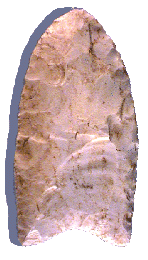

Point Type: CLOVIS
Also See: Allen, Agate Basin, Angostura, Anzick, Browns Valley,
Conerly, Copena, Auriculate, Cumberland, Dalton, Debert, Folsom, Holcombe, Lincoln Hills
Fluted, Llano, Plainview, Redstone, Sandia, Simpson, Suwanee
Location: All of North America
Associated Dates:
15,000 - 9,000 B.P. - Early Paleo
Morphology: Auriculate
General Description: The Clovis blade is a medium to large sized, auriculated, fluted, lanceolate point with excurvate sides and a concave base that is ground. Usually there is a slight contraction or tapering at the base. The widest part of the blade is either midway up along the blade or on resharpened specimens at the base. Most examples are fluted on both sides with the flute extending about one third the way up from the base to the tip but vary in length from minor to full length of the blade. Some examples can show multiple flutes on each side. The flaking on the Clovis can be random to parallel. The edges of the stem where hafting would occur are usually ground. The Clovis type points are are recognizable in pristine form but may lack many of specific type characteristics described above in reworked or end-of-life / discard form. Materials chosen by Paleo-Indians in the manufacture of Clovis points seem to be fine or high grade flints, cherts, chalcedony and jaspers.
The Clovis is considered by many to represent the earliest projectile point used by Paleo-Indian people in North America. It it hypothesized that the blade was developed in North America after early man cross the Bearing Straits to reach this continent, about 50,000 years ago. The blade's origin is also thought to have been influenced by migrations from Europe. Current theories place the Clovis' origin point to be in the Southeastern U.S. since more examples are found in Florida, Alabama and Tennessee than anywhere else. There are many subtle variations in the Clovis type as indicated by the large Also See: list above. The Clovis is part of a family or cluster of associated points with regional variations and sub-types.
The size of the Clovis point's size can range from 24 mm to 150 mm in length with the typical point being in the 50 mm to 74 mm range.
The Clovis was named by Edgar B. Howard for his work in Clovis, New Mexico where the point was found and associated with the remains of an extinct species. It appears that the type was first recognized at Backwater Draw, Eastern New Mexico, by E. H. Sellards, 1952. The type was first reported by J.D. Figgins in 1933, from examples found with extinct mammal bones.
About the Point Above: The point pictured at the top of this page, was found in Pike County, Illinois. It is made from fine white chert which has minute, rust colored inclusions. It is fluted on both sides. The flute on the photographed side is 20 mm in length while the flute on the opposite side is 24 mm in length. Overall, the point measures 57 mm in length, is 28 mm wide (at 21 mm from the base) and is only 12 mm thick (mid blade at the point where the flutes end). The base measures 26 mm in width and the concavity of the base is 8 mm deep. The base is ground as are the blade edges running 22 mm up from the ears of the base. Close microscopic examination reveals rounding/polishing of most high ridges of the knapping scars, probably due to the natural effects of either erosion, abrasion, or weathering after discard or loss. A faint yellowish patina is present on both sides of the blade. Catalog Number 1-185-G
References: Baker, Bell (1), Davis, Dragoo (a, d), Justice, Fogleman, Hranicky, Overstreet, Perino (1), Puckett (1), Ritchie, Sowell & Nowak, Waldorf
© Copyright 1997 - 2008 LITHICS-Net WWW.LITHICSNET.COM
Use Your Browser's BACK Button to Return to the Lithics-Net Index.